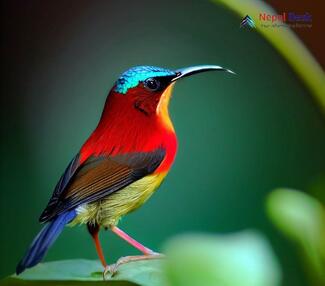In the shadows of Nepal's towering peaks, a tiny bird with a metallic green tail works tirelessly—pollinating flowers that sustain entire ecosystems. Meet the Green-Tailed Sunbird (Aethopyga nipalensis), Nepal's unsung ecological hero. Known locally as बुङ्गेचरा (Bungēcharā), this remarkable avian species has evolved to become an integral part of the Himalayan ecosystem, yet remains largely unknown to the wider world.
A Living Legacy of Himalayan Evolution
The Green-tailed Sunbird represents a masterpiece of evolutionary adaptation to life in the harsh Himalayan environment. As a common resident of Nepal's mid-hills to alpine zones, this species has developed remarkable strategies for survival at elevations ranging from 1,800 to 3,500 meters. Recent research from the Nepal Bird Conservation Network reveals that these birds maintain viable populations across major protected areas, including the Langtang Valley, Annapurna Sanctuary, and Makalu-Barun region.
What makes this species particularly fascinating is its sophisticated response to seasonal changes. Unlike many high-altitude birds that migrate horizontally to different regions, the Green-tailed Sunbird employs a vertical migration strategy. During winter months, these birds descend to lower elevations, following a carefully timed schedule that coincides with the blooming patterns of key nectar sources, particularly the iconic Rhododendron arboreum (Nepal's national flower) and the Himalayan Honeysuckle.
Architectural Marvel of Nature
The physical adaptations of the Green-tailed Sunbird showcase nature's incredible attention to detail. Male specimens display an almost jewel-like appearance, with an iridescent green crown that shifts colors in different lights, complemented by a brilliant crimson throat and their namesake emerald tail. This striking coloration serves multiple purposes, from mate attraction to territorial signaling among the dense rhododendron forests.
Female birds, by contrast, wear a more subdued olive-green plumage, an adaptation that proves crucial during the nesting season. This natural camouflage allows them to tend to their nests without drawing attention from predators, particularly during the vulnerable breeding period between April and July. Recent studies by the Nepal Ornithological Union have documented remarkable nest-building techniques, where females construct elaborate pendant nests using spider webs, plant fibers, and moss, creating structures that can withstand harsh mountain weather conditions.
Engineering Excellence in Feeding Apparatus
Perhaps the most remarkable feature of the Green-tailed Sunbird is its highly specialized feeding apparatus. The bird possesses a needle-like curved bill perfectly engineered for accessing nectar from deep-throated Himalayan flowers. This bill works in concert with a specialized tubular tongue that can extend well beyond the bill's length, allowing access to nectar pools that would be unreachable for other species.
The bird's metabolic demands are extraordinary, requiring daily nectar consumption equivalent to 150% of its body weight. This high energy requirement drives a constant foraging pattern that, in turn, provides essential pollination services to the ecosystem. Research conducted at the National Trust for Nature Conservation in Nepal has demonstrated that a single Green-tailed Sunbird can visit up to 1,800 flowers in one day during peak flowering seasons.
Ecological Cornerstone of High-Altitude Ecosystems
The ecological significance of the Green-tailed Sunbird extends far beyond its role as a nectar feeder. As primary pollinators for high-altitude flowers like Codonopsis and the rare Blue Poppy (Meconopsis), these birds maintain genetic diversity in plant populations that are crucial for ecosystem stability. Their pollination services ensure successful seed production for plants that play vital roles in preventing soil erosion on steep Himalayan slopes.
Additionally, these sunbirds demonstrate remarkable dietary flexibility, supplementing their nectar diet with small insects, particularly aphids and spiders. This behavior contributes to natural pest control in high-altitude agricultural areas and natural ecosystems. Recent studies in the Annapurna Conservation Area have shown that areas with healthy sunbird populations experience significantly lower rates of aphid-related damage to native plants.
Conservation Challenges and Future Prospects
Despite their current "common" status, Green-tailed Sunbirds face mounting challenges from climate change and habitat modification. Rising temperatures are affecting the timing of flower blooming cycles, potentially creating mismatches between the birds' breeding seasons and peak nectar availability. The Nepal Bird Conservation Network has documented shifts in the altitudinal range of these birds over the past decade, with populations moving progressively higher to track suitable habitat conditions.
Conservation efforts are now focusing on protecting key nectar corridors—continuous strips of habitat that allow these birds to move safely between different elevational zones. The Department of National Parks and Wildlife Conservation in Nepal has initiated a program to maintain and restore native flowering plants along these corridors, particularly focusing on rhododendron species that serve as critical nectar sources.
Future Research Directions and Opportunities
Looking ahead, several exciting research opportunities could enhance our understanding of these remarkable birds. Emerging technologies like miniature GPS trackers could help map detailed movement patterns during altitudinal migrations. Additionally, DNA analysis of pollen carried by these birds could provide valuable insights into plant-pollinator networks in the Himalayas.
For eco-tourists and wildlife enthusiasts, the Green-tailed Sunbird offers unique opportunities for observation and photography, particularly during the spring rhododendron blooming season. Several community-based conservation initiatives now offer guided birding tours that combine sunbird observation with local cultural experiences, providing sustainable income sources for mountain communities while promoting conservation awareness.
The story of Nepal's Green-tailed Sunbird is far from complete. As we continue to uncover the intricate ways these birds interact with their environment, they remind us of the remarkable adaptations that allow life to thrive in Earth's most challenging environments. Their presence in the Himalayan ecosystem serves as a testament to nature's resilience and the importance of preserving these unique ecological relationships for future generations.
From Cultural Obscurity to Scientific Significance
Despite its ecological importance, the Green-tailed Sunbird has long dwelled in the cultural shadows of Nepal's more celebrated avian species. While the Danphe (Himalayan Monal) graces Nepal's currency and the Cheer Pheasant features prominently in local folklore, the Green-tailed Sunbird remained largely unnoticed in traditional narratives. This oversight stems partly from the human tendency to notice larger, more dramatic birds while overlooking the subtle yet crucial roles of smaller species.
However, recent years have witnessed a remarkable shift in recognition. Professional birding organizations like Himalayan Birding Adventures now feature the Green-tailed Sunbird as a flagship species in their specialized tours. Their detailed observation records have contributed significantly to the scientific understanding of the species' behavior patterns and habitat preferences. Furthermore, climate researchers have identified these sunbirds as excellent bioindicators for monitoring ecosystem health in response to global warming, given their sensitive dependence on synchronized flowering patterns.
Conservation Challenges in a Changing Landscape
The threats facing the Green-tailed Sunbird exemplify the complex challenges of wildlife conservation in developing nations. Along the popular Annapurna Circuit, expanding tourism infrastructure has led to significant habitat fragmentation. Recent surveys by the Department of National Parks and Wildlife Conservation indicate that road construction has disrupted traditional nesting sites, particularly in areas below 2,500 meters. Additionally, climate change has begun altering the delicate timing of flowering seasons, creating what scientists term "phenological mismatches" between the birds' breeding cycles and peak nectar availability.
Nepal's response to these challenges demonstrates the innovative integration of conservation with community development. In Ghandruk and Lamjung, local community forest user groups have established protected zones specifically designed to preserve sunbird habitat. These initiatives combine traditional ecological knowledge with modern conservation practices. For instance, the community forests maintain buffer zones of native flowering plants around agricultural areas, creating wildlife corridors that support both sunbird populations and local livelihoods.
Citizen science has emerged as a powerful tool in monitoring these conservation efforts. The eBird Nepal platform, launched in collaboration with Cornell University, has accumulated over 5,000 Green-tailed Sunbird observations since 2018. This growing database enables researchers to track population trends and identify critical habitat areas requiring enhanced protection.
A Guide to Sunbird Spotting
For wildlife enthusiasts hoping to observe these remarkable birds, timing, and location are crucial. The period from March to June offers optimal viewing opportunities, coinciding with the explosive blooming of rhododendrons across Nepal's middle hills. During this season, male Green-tailed Sunbirds become particularly active and visible, establishing and defending nectar-rich territories with spectacular aerial displays.
Shivapuri Nagarjun National Park, located just outside Kathmandu, provides accessible viewing opportunities for both novice and experienced birders. The park's well-maintained trails wind through prime sunbird habitat, with several observation points strategically positioned near flowering hotspots. The Ghorepani-Poon Hill trek offers another excellent viewing location, where the birds can be observed amid stunning mountain vistas and the world's largest rhododendron forest.
Success in spotting these diminutive birds often depends on recognizing their distinctive vocalizations. Their high-pitched "tsee-tsee" calls, typically heard during early morning feeding sessions, serve as reliable indicators of their presence. Experienced guides recommend focusing observation efforts during the first few hours after sunrise when males actively defend their territories and engage in dramatic aerial pursuits of rivals.
Through careful observation and protection of these remarkable birds, we not only preserve a crucial component of Nepal's biodiversity but also maintain essential ecological processes that support human communities across the Himalayas. The growing appreciation for the Green-tailed Sunbird represents a broader shift in conservation thinking, recognizing that even the smallest species play vital roles in maintaining healthy mountain ecosystems.




